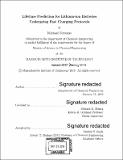| dc.contributor.advisor | Richard D. Braatz. | en_US |
| dc.contributor.author | Forsuelo, Michael. | en_US |
| dc.contributor.other | Massachusetts Institute of Technology. Department of Chemical Engineering. | en_US |
| dc.date.accessioned | 2019-07-18T20:27:46Z | |
| dc.date.available | 2019-07-18T20:27:46Z | |
| dc.date.copyright | 2019 | en_US |
| dc.date.issued | 2019 | en_US |
| dc.identifier.uri | https://hdl.handle.net/1721.1/121777 | |
| dc.description | Thesis: S.M., Massachusetts Institute of Technology, Department of Chemical Engineering, 2019 | en_US |
| dc.description | Cataloged from PDF version of thesis. | en_US |
| dc.description | Includes bibliographical references (pages 83-87). | en_US |
| dc.description.abstract | This thesis describes the application of Porous Electrode Theory and supervised machine learning to lifetime prediction for 18650 lithium iron phosphate (LiFePO₄ LFP)/graphite cells subject to mixed galvanostatic and potentiostatic fast charging policies. Porous Electrode Theory is used to predict battery lifetime by parameteric reductions of effective solid-phase Fickian diffusivities, electrolytic Stefan-Maxwell diffusivity, and Butler-Volmer exchange currents. Parameter estimation and uncertainty quantification are formulated as least squares optimization over galvanostatic discharge curves with Bayesian estimation of uncertainties. A battery lifetime approach from the literature is extended with identifiability analysis to enhance fidelity of the inverse problem, the attribution of degradation modes, and the accuracy of parametric power-law lifetime predictions. Multiphase Porous Electrode Theory (MPET) is also explored in this thesis. In MPET, each particle of the porous electrode ensemble is described by generalized Allen-Cahn-Hilliard dynamics. Single-particle dynamics are governed by firstprinciples free energy landscapes as opposed to inductive fits to open-circuit battery voltages. Multiscale parameter estimation and central limit theorem analysis are implemented, enhancing the suitability of MPET for capacity fade predictions. Supervised machine learning algorithms utilizing feature-based correlations for battery lifetime are described. Electrochemical features that go beyond the discharge-only model provide improved lifetime predictions, generalized voltage analysis indiscrimant of (dis)charge protocol or data, and a clear connection between battery physics and machine learning, and suggest an optimal charging protocol. | en_US |
| dc.description.statementofresponsibility | by Michael Forsuelo. | en_US |
| dc.format.extent | 115 pages | en_US |
| dc.language.iso | eng | en_US |
| dc.publisher | Massachusetts Institute of Technology | en_US |
| dc.rights | MIT theses are protected by copyright. They may be viewed, downloaded, or printed from this source but further reproduction or distribution in any format is prohibited without written permission. | en_US |
| dc.rights.uri | http://dspace.mit.edu/handle/1721.1/7582 | en_US |
| dc.subject | Chemical Engineering. | en_US |
| dc.title | Lifetime prediction for lithium-ion batteries undergoing fast charging protocols | en_US |
| dc.type | Thesis | en_US |
| dc.description.degree | S.M. | en_US |
| dc.contributor.department | Massachusetts Institute of Technology. Department of Chemical Engineering | en_US |
| dc.identifier.oclc | 1103320000 | en_US |
| dc.description.collection | S.M. Massachusetts Institute of Technology, Department of Chemical Engineering | en_US |
| dspace.imported | 2019-07-18T20:27:44Z | en_US |
| mit.thesis.degree | Master | en_US |
| mit.thesis.department | ChemEng | en_US |
